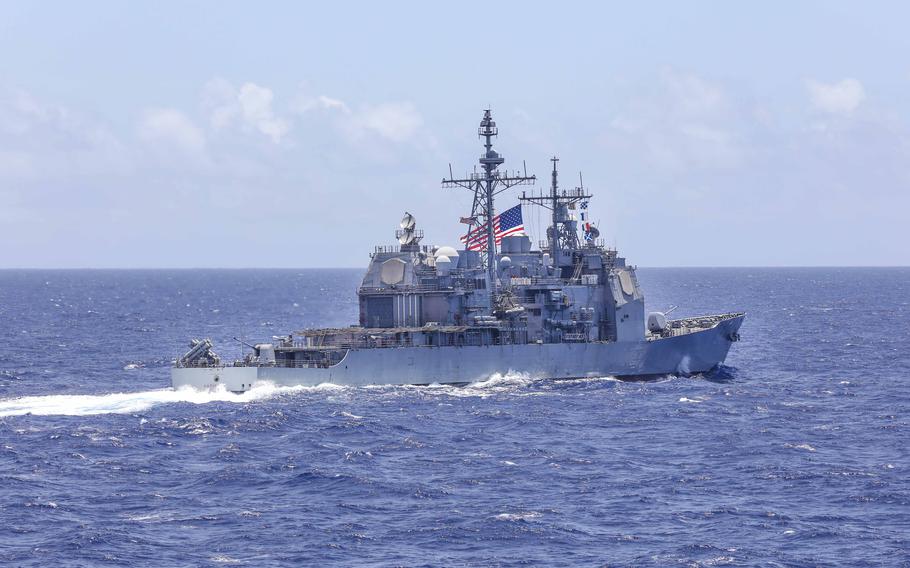
The Ticonderoga-class, guided-missile cruiser USS Antietam cruises in the Philippine Sea on June 3, 2023. (Deanna C. Gonzales/U.S. Navy)
WASHINGTON — A Navy plan to retire ships, buy fewer new ones and delay some shipbuilding drew sharp words from House lawmakers during a hearing Wednesday to examine the service’s budget proposal for 2025.
“China remains… the pacing threat. In a China scenario, the Navy remains our cornerstone of our military’s ability to project power,” said Rep. Ken Calvert, R-Calif., chairman of the House Appropriations Committee’s defense subpanel. “I am concerned the Navy is falling behind.”
The Navy and Marines budget for fiscal 2025 unveiled last month totals $257.6 billion. Though a slight increase from the previous year, the proposal includes fewer purchases of Virginia-class attack submarines and F-35 Lightning II fighter jets. It also plans for long-term projects such as a second Columbia-class, ballistic-missile submarine and two more Ford-class aircraft carriers.
Yet the Navy also seeks to get rid of 19 ships, including 10 before reaching their expected service life, a move Congress has been reluctant to support in recent years.
“The Navy continues to retire ships faster than it builds them. And I’m troubled by the Navy’s request to decommission 10 ships before the end of their service life,” Calvert said.
The budget hearing followed an announcement last week from the service that four of its critical shipbuilding plans are years behind schedule. The delays, from one to three years each depending on the program, come as the Navy and Pentagon pour billions of dollars into modernizing and upgrading shipyards to build and repair ships more quickly and keep pace with China’s growing military.
The first Columbia-class submarine is projected to be between 12 and 16 months late. The fourth and fifth blocks, or more modernized versions, of the Virginia-class submarines are 36 and 24 months late. The first Constellation-class frigate is approximately 36 months behind schedule. The third Gerald R. Ford-class aircraft carrier, the USS Enterprise, is approximately 18 to 26 months late. Delays range from issues related to acquisition and contract strategy, the supply chain and having enough skilled workers.
“We cannot continue to divest ships without investing adequately in ship construction. I’m particularly troubled by the Navy’s recent report,” said Rep. Tom Cole, R-Okla., chairman of the House Appropriations Committee. “These four programs … are vital to counter China in the Pacific.”
Cole said he believes the Navy budget is “too low” but recognizes Congress is under constraints forged last year under the Fiscal Responsibility Act. The law capped the Defense Department budget for 2025 at $849.5 billion, a roughly 1% cut to the department’s 2024 spending plan when adjusted for inflation.
He said shipbuilding is key.
“We can give you a lot of money but you clearly don’t have the capacity to produce as quickly as we would like to,” Cole said.
Navy Secretary Carlos Del Toro, who testified about the service’s budget at the hearing, explained the approach that he introduced in the fall calls for a “whole-of-government effort” to build a comprehensive U.S. and allied maritime power in commercial and naval abilities. Del Toro said commercial shipbuilding has been “devastated” in the country since the 1980s.
“We stopped actually incentivizing and subsidizing the commercial shipbuilding industry. And it’s because of that, that our shipyards went down from 30 to eight today that basically work with the Navy,” the secretary said. “And that’s a real challenge.”
This leads to the problem of ships costing more to build in the U.S., he said.
A way to address the issue is through existing authorities. Title 46 of the Code of Federal Regulations allows the secretary of the Department of Homeland Security, the secretary of the Transportation Department and the Navy secretary to deem a ship to have dual use — commercial and military — which permits the builder to receive subsidies, Del Toro said.
“So if a ship costs, say $100 million, to build here in the United States but actually costs $80 million overseas, we could subsidize that shipbuilder with $20 million. We have to get innovative [in] how we actually grow the commercial ship industry,” he said.